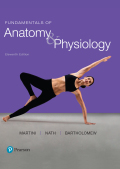
Fundamentals of Anatomy & Physiology (11th Edition)
11th Edition
ISBN: 9780134477336
Author: Martini
Publisher: PEARSON
expand_more
expand_more
format_list_bulleted
Concept explainers
Question
Chapter 26, Problem 1CP
Summary Introduction
To determine:
The major functions of the urinary system.
Introduction:
The most of the
Expert Solution & Answer
Explanation of Solution
The urinary system includes the production, storing and elimination of urine. The major functions of the urinary system are as follow:
- Excretion: The removal of metabolic waste products from body fluids.
- Elimination: When the waste out from the body is discharged.
- Homeostatic regulation: Regulating blood volume, blood pressure, regulation of plasma concentration of sodium, potassium, chloride and other ions, stabilizing pH of blood and so on.
Want to see more full solutions like this?
Subscribe now to access step-by-step solutions to millions of textbook problems written by subject matter experts!
Students have asked these similar questions
When beta-lactamase was isolated from Staphylcoccus aureus and treated with a phosphorylating agent, only the active site, serine was phosphorylated. Additionally, the serine was found to constitute 0.35% (by weight) of this beta-lactamase enzyme. Using this, calculate the molecular weight of this enzyme and estimate the number of amino acids present in the polypeptide.
Based on your results from the Mannitol Salt Agar (MSA) media, which of your bacteria were mannitol fermenters and which were not mannitol fermenters?
help tutor please
Chapter 26 Solutions
Fundamentals of Anatomy & Physiology (11th Edition)
Ch. 26 - Prob. 1CPCh. 26 - Prob. 2CPCh. 26 - Prob. 3CPCh. 26 - Prob. 4CPCh. 26 - Damage to which part of a nephron would interfere...Ch. 26 - Prob. 6CPCh. 26 - Prob. 7CPCh. 26 - List the factors that influence net filtration...Ch. 26 - Prob. 9CPCh. 26 - Prob. 10CP
Ch. 26 - Prob. 11CPCh. 26 - Prob. 12CPCh. 26 - Prob. 13CPCh. 26 - Prob. 14CPCh. 26 - Prob. 15CPCh. 26 - What effect would a high-protein diet have on the...Ch. 26 - Prob. 17CPCh. 26 - Prob. 18CPCh. 26 - Prob. 19CPCh. 26 - Define nephrolithiasis.Ch. 26 - Prob. 21CPCh. 26 - Prob. 22CPCh. 26 - Prob. 23CPCh. 26 - Prob. 1RQCh. 26 - The basic functional unit of the kidney is the (a)...Ch. 26 - The process of urine formation involves all of the...Ch. 26 - Prob. 4RQCh. 26 - The distal convoluted tubule is an important site...Ch. 26 - Prob. 6RQCh. 26 - Prob. 7RQCh. 26 - Prob. 8RQCh. 26 - Trace the pathway of the protein-free filtrate...Ch. 26 - Prob. 10RQCh. 26 - Prob. 11RQCh. 26 - Prob. 12RQCh. 26 - Prob. 13RQCh. 26 - What are the primary effects of angiotensin II on...Ch. 26 - Prob. 15RQCh. 26 - When the renal threshold for a substance exceeds...Ch. 26 - Prob. 17RQCh. 26 - Prob. 18RQCh. 26 - When ADH levels rise, (a) the amount of water...Ch. 26 - The control of blood pH by the kidneys during...Ch. 26 - Prob. 21RQCh. 26 - Prob. 22RQCh. 26 - Prob. 23RQCh. 26 - Prob. 24RQCh. 26 - Prob. 25RQCh. 26 - Prob. 26RQCh. 26 - In response to excess water in the body, (a)...Ch. 26 - Prob. 28RQCh. 26 - Prob. 29RQCh. 26 - What effect would drinking a solution of mannitol...Ch. 26 - The drug Diamox is sometimes used to treat...Ch. 26 - Prob. 1CCCh. 26 - What will likely happen to the glomerular...
Knowledge Booster
Learn more about
Need a deep-dive on the concept behind this application? Look no further. Learn more about this topic, biology and related others by exploring similar questions and additional content below.Similar questions
- Q8. A researcher wants to study the effectiveness of a pill intended to reduce stomach heartburn in pregnant women. The researcher chooses randomly 400 women to participate in this experiment for 9 months of their pregnancy period. They all need to have the same diet. The researcher designs two groups of 200 participants: One group take the real medication intended to reduce heartburn, while the other group take placebo medication. In this study what are: Independent variable: Dependent variable: Control variable: Experimental group: " Control group: If the participants do not know who is consuming the real pills and who is consuming the sugar pills. This study is It happens that 40% of the participants do not find the treatment helpful and drop out after 6 months. The researcher throws out the data from subjects that drop out. What type of bias is there in this study? If the company who makes the medication funds this research, what type of bias might exist in this research work?arrow_forwardHow do I determine the inhertiance pattern from the pedigree diagram?arrow_forwardits an open book assignemntarrow_forward
- Describe two different gene regulation mechanisms involving methylationarrow_forwardWhat is behavioral adaptarrow_forward22. Which of the following mutant proteins is expected to have a dominant negative effect when over- expressed in normal cells? a. mutant PI3-kinase that lacks the SH2 domain but retains the kinase function b. mutant Grb2 protein that cannot bind to RTK c. mutant RTK that lacks the extracellular domain d. mutant PDK that has the PH domain but lost the kinase function e. all of the abovearrow_forward
arrow_back_ios
SEE MORE QUESTIONS
arrow_forward_ios
Recommended textbooks for you
 Human Physiology: From Cells to Systems (MindTap ...BiologyISBN:9781285866932Author:Lauralee SherwoodPublisher:Cengage Learning
Human Physiology: From Cells to Systems (MindTap ...BiologyISBN:9781285866932Author:Lauralee SherwoodPublisher:Cengage Learning


Human Physiology: From Cells to Systems (MindTap ...
Biology
ISBN:9781285866932
Author:Lauralee Sherwood
Publisher:Cengage Learning




12 Organ Systems | Roles & functions | Easy science lesson; Author: Learn Easy Science;https://www.youtube.com/watch?v=cQIU0yJ8RBg;License: Standard youtube license